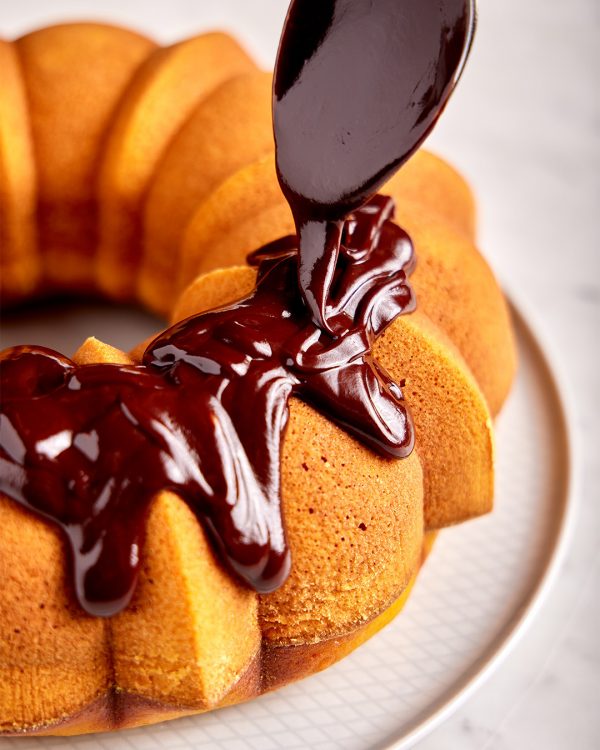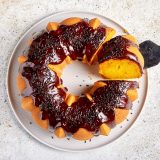In American carrot cake, the signature ingredient typically shows up as grated shreds punctuating a brown batter, the carrot flavor lost to warming spices and thick sugary frosting. Brazilian carrot cake, known as bolo de cenoura, is another matter. This cake is so carroty, it’s actually orange, with a robust, earthy flavor that shines through. We assumed this was due to a higher volume of carrots, but the difference turned out to be not in the amount of carrots, but in how they are prepped.
As we attempted to recreate this chocolate-glazed treat, we learned that bolo de cenoura coaxes more flavor from its carrots by pureeing them rather than grating them. And doing so not only ups the flavor, it also transforms the cake’s texture. And—as a bonus—it happens to be a lot easier and faster.
Bolo de cenoura is one of many Brazilian blender cakes, or bolos de liquidificador, with flavors ranging from corn to coconut to passion fruit. As the name suggests, this style of dessert relies on the blender to eliminate the need for chopping or grating. Here, carrots also add moisture. And once pureed, carrots can more fully infuse the cake with a subtle earthy sweetness, giving it a depth not found in cakes sweetened with just sugar and grated carrots.

While American carrot cake is thickly frosted, Brazilian bolo de cenoura opts for a simple chocolate glaze. Glazes are a classic choice for Bundt cakes, as they enrobe the cake, complementing its shape. And though chocolate glazes can run a wide gamut (for example, some call for gelatin), our version requires nothing more than semisweet chocolate, orange juice and oil. But here, timing is everything. We bring orange juice to a simmer, then whisk it into the chocolate until smooth and add oil for luster. We then cool it to room temperature, just until it is sufficiently liquid to pour over the cake, yet just solid enough to adhere to the surface. Too warm, and the glaze won’t stick; too cool, and it won’t pour. To check for the right consistency, give it the spoon-lift test: The glaze should pour off the spoon in globs and mound onto itself in the bowl. Also, the cake should be fully cooled, or else the glaze will melt and slide off. To glaze the cake, set it on a platter and drizzle the glaze over it, then rap the platter against the counter so it runs down the sides. And if your glaze thickens before you can use it, simply reheat it gently in the microwave at 50 percent power, then stir vigorously to restore it to its glossy state.
Why does the blender produce better flavor? Turns out, the more you rupture the cell structure of root vegetables such as carrots, the more sugars and flavorful hydrocarbons they release. It’s a technique we use often in salads at Milk Street. For salads that taste sweeter and fresher, we grate carrots rather than slice or chop. Pureeing takes this effect to another level.
As a test, we experimented with making bolo de cenoura using grated carrots. It turned out far drier, lacking not only the dramatic color of the blender version, but also its richness. The results were clear: The blender makes all the difference.
Here, the blender eliminates the need for chopping or grating. And once pureed, carrots can more fully infuse the cake with a subtle earthy sweetness, giving it extra depth.
Bolo de cenoura also relies on another tried-and-true trick for tender cake. Rather than butter, the cake is made with oil, which does a better job than butter keeping cakes moist. All fats coat flour, preventing gluten formation and promoting a tender (not chewy) crumb. But oil has a special advantage: It stays liquid at room temperature. By contrast, cakes made with butter tend to firm up as they cool, as the butter returns to solid form even at room temperature.
Many recipes for bolo de cenoura further enrich the cake with sour cream or other dairy, but we decided to nudge things in a more tropical direction with coconut cream—the thick, rich cream extracted from the grated meat of coconuts. Coconut milk won’t work, as its thinner consistency will produce a wet batter and, ultimately, a dense cake. (Also avoid cream of coconut, a sugary cocktail ingredient.) In our testing, we found that coconut cream helps keep the crumb light and fluffy.
We love the three-step simplicity of this cake. First, the dry ingredients are whisked together. Then, the carrots are pureed with coconut cream, sugar, oil, eggs, vanilla and orange zest (which punctuates the cake with pleasant bursts of citrus without adding liquid). Finally, the wet and dry mixtures are combined, then baked.
Once the cake has cooled, it’s covered in a simple chocolate glaze, then showered in candy sprinkles. For our version, we spike the glaze with a bit of orange juice to ensure that our bolo de cenoura tastes as bright as it looks.
Related Recipes
January - February 2024

Sign up to receive texts
Successfully signed up to receive texts!
We'll only send our very best offers - Like a $15 store credit to start.
By entering your phone number and submitting this form, you consent to receive marketing text messages (such as promotion codes and cart reminders) from Christopher Kimball's Milk Street at the number provided, including messages sent by autodialer. Consent is not a condition of any purchase. Message and data rates may apply. Message frequency varies. You can unsubscribe at any time by replying STOP or clicking the unsubscribe link (where available) in one of our messages. View our Privacy Policy and Terms of Service.







